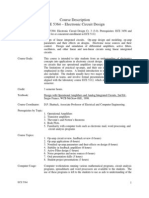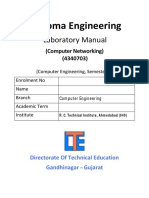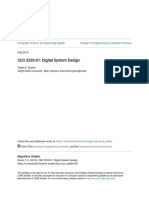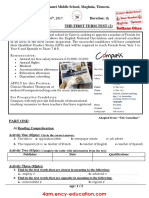CEA (Network Analysis)
CEA (Network Analysis)
Uploaded by
h24820909Copyright:
Available Formats
CEA (Network Analysis)
CEA (Network Analysis)
Uploaded by
h24820909Original Description:
Copyright
Available Formats
Share this document
Did you find this document useful?
Is this content inappropriate?
Copyright:
Available Formats
CEA (Network Analysis)
CEA (Network Analysis)
Uploaded by
h24820909Copyright:
Available Formats
Complex Engineering Analysis
Subject: Electrical Network Analysis
Course Code: EE-105
Semester Spring 2024
Instructor: Engr. Ambreen Javed
Objective:
The objective of this complex engineering problem is to investigate and design a practical problem
that has following attributes:
1. The activity requires abstract thinking, originality in analysis to formulate suitable software
and hardware models of the activity.
2. The activity involves creative use of engineering principles and research-based knowledge in
novel ways.
Complex Engineering Problem Outcomes (CEAO):
The outcome of this activity is that the students may be able to partially attain some or all of the
following graduate attributes.
1. GA1: Engineering Knowledge
2. GA2: Problem Analysis
3. GA3: Design/Development of solutions
4. GA4: Investigation
5. GA5: Modern Tool Usage
6. GA6: The Engineer and Society
7. GA7: Environment and Sustainability
8. GA8: Professional Ethics
9. GA9: Individual and Teamwork
10. GA10: Communication
11. GA11: Project Management
12. GA12: Lifelong Learning
In this course, this problem maps onto CLO3 and your performance in this task will play an important
role in the attainment of this course learning outcome.
Apply mathematical techniques to analyze circuit response and
CLO3 PLO4 C3
obtain frequency response of linear circuits
Task Goals:
The goals of this engineering problem are to:
1. Design an electric circuit according to given specifications.
2. Gain experience with techniques used to design electric circuits.
3. Perform the phasor analysis of the circuit
4. Perform the mathematical calculations
5. Learn to test circuit with simulation.
6. Learn to perform physical testing of the circuit.
7. Learn how to work in a team.
8. Learn how to write a project report
Problem Statement:
To design a Passive Band Pass Filter using a combination of Low Pass and High Pass Filter based on the
knowledge and skills gained during lectures and lab sessions as per following requirements.
a) High Pass Filter’s cut-off frequency should be equal to Last two digits of your registration
number ( in KHz)
b) Low Pass Filter’s cut-off frequency should be equal to sum of last two digits of your registration
number plus 20 KHz
For example
For the registration number, 151091, the cut-off frequencies will be as follows:
𝑓1 = (91KHZ), 𝑓2 = (91+20) KHz
c) Calculate the specific values of Resistors and Capacitors for both filters separately.
d) Make a table of frequencies and 𝑉𝑜 for at least 30 values of frequencies and make a graph of
frequencies vs. 𝑉𝑜 using the values of the table.
1. Choose 3 values between 𝑓1 and 𝑓2 and rest outside the range 𝑓1 -𝑓2 for the table
2. Select step size of 200Hz.
e) Also obtain phasor graph for the designed filter
This is a group activity, and each group can have no more than 3 members. The submission
deadline for this activity is 19th May, 09:00 AM.
Deliverables:
A detailed report explaining the design parameters and their analysis in terms of frequency and
phasor response. You are supposed to include the screenshots of simulation and hardware circuit.
(20)
Policy on Professional Ethics & Plagiarism:
You are free to consult any book and online resources during the design and analysis phase, but you
could not copy from them. Your design and implementation must be your original effort and same
apply for simulations. Remember that if anyone is found to copy from the Internet or other group
members, the group shall face severe penalty. You are not allowed to copy any material or code
directly from the web or elsewhere. Note that if you are found to violate this policy or it becomes
obvious that the work you have submitted is not your own or has been taken from some other source
you shall be facing severe consequences.
The Formula that will be generously applied in all cases is:
Final Score = Raw Score – 2*CF*Total
Where CF is the Copying Factor. This means that even if you are found to copy only in 50% of the
activity deliverables, and you end up scoring 100% raw score, but your final score will be 0. Please
follow the principle that “Honesty is the Best Policy”.
You might also like
- (Ebook PDF) Staffing Organizations 8th Edition by Heneman Download PDFDocument43 pages(Ebook PDF) Staffing Organizations 8th Edition by Heneman Download PDFnishomeyvisNo ratings yet
- Lab Manual SCOA 20 21Document37 pagesLab Manual SCOA 20 21Anuj Padmawar0% (1)
- Project Proposal On Peer PressureDocument23 pagesProject Proposal On Peer PressureNaty BrucalNo ratings yet
- Nca - CeaDocument2 pagesNca - CeaMuhammad Ali RazaNo ratings yet
- Project - Design of Notch Filter v2 - VerifiedDocument12 pagesProject - Design of Notch Filter v2 - Verifieds.mahadrNo ratings yet
- Complex Engineering Problem: ObjectiveDocument3 pagesComplex Engineering Problem: ObjectiveUsman AslamNo ratings yet
- (Sample) Lab Report Template - Body Page (Programming Lab)Document5 pages(Sample) Lab Report Template - Body Page (Programming Lab)ShourovNo ratings yet
- Resit Deferral Individual Project Assignment Brief 4037cemDocument8 pagesResit Deferral Individual Project Assignment Brief 4037cemAtif khanNo ratings yet
- Course Description ECE 5364 - Electronic Circuit DesignDocument3 pagesCourse Description ECE 5364 - Electronic Circuit DesignchandravinitaNo ratings yet
- IntegratedCircuitsLab EE0313Document94 pagesIntegratedCircuitsLab EE0313scribdsurya4uNo ratings yet
- Eee433 Fa09 AicDocument2 pagesEee433 Fa09 AicShanmukh SudheendraNo ratings yet
- ADE Lab ManualDocument59 pagesADE Lab ManualShreevas NandanNo ratings yet
- ECE279 - Zero - Lecture - 2023 - UpdatedDocument31 pagesECE279 - Zero - Lecture - 2023 - Updatedkofineg493No ratings yet
- Network Lab Manual 5th Sem 2017-18Document60 pagesNetwork Lab Manual 5th Sem 2017-18Sam82% (17)
- Ece006 Labexercise12Document15 pagesEce006 Labexercise12Krizzia Anne ShengNo ratings yet
- DVD ManualDocument125 pagesDVD Manualmadhusudhantm.ec21No ratings yet
- Commissioning of Steam Turbine GeneratorsDocument6 pagesCommissioning of Steam Turbine GeneratorsiftikharNo ratings yet
- COMP254 - 009 - Assignment 2Document2 pagesCOMP254 - 009 - Assignment 2tessliz2003No ratings yet
- (BNJ10903) LAB 01 - Resistors Network and CircuitDocument15 pages(BNJ10903) LAB 01 - Resistors Network and CircuitMuhammad NaufalNo ratings yet
- Course - Syllabus - COE 351 - Spring 2020 PDFDocument6 pagesCourse - Syllabus - COE 351 - Spring 2020 PDFsaudNo ratings yet
- DLD EXP 1 and 2Document20 pagesDLD EXP 1 and 2Muhammad UsmanNo ratings yet
- Staff ManualDocument44 pagesStaff ManualRamesh LNo ratings yet
- EE305 Course Project - Spring 2023Document8 pagesEE305 Course Project - Spring 2023khan aliNo ratings yet
- Lab Manual CNS Part-1Document11 pagesLab Manual CNS Part-1vishwas guptaNo ratings yet
- Laboratory Manual: Power System Analysis-Ii (18EE72)Document84 pagesLaboratory Manual: Power System Analysis-Ii (18EE72)Saumya SinghNo ratings yet
- 2023-Wireless Communications-CEP-ProjectDocument4 pages2023-Wireless Communications-CEP-Projectm.attique3627No ratings yet
- 2011 5333 Harjani ProjectDocument4 pages2011 5333 Harjani ProjectfammafNo ratings yet
- COURSE Project (25%) : Electromechanical Motion Devices EE 321Document10 pagesCOURSE Project (25%) : Electromechanical Motion Devices EE 321Assma MohamedNo ratings yet
- COURSE Project (25%) : Electromechanical Motion Devices EE 321Document9 pagesCOURSE Project (25%) : Electromechanical Motion Devices EE 321Shehab AshrafNo ratings yet
- Lab Manual: Meerut Institute of Engineering & TechnologyDocument32 pagesLab Manual: Meerut Institute of Engineering & TechnologyDeepak SharmaNo ratings yet
- COURSEWORK 2022/2023: IMAT5122 - Computer Systems and NetworksDocument10 pagesCOURSEWORK 2022/2023: IMAT5122 - Computer Systems and Networksxingyu zhangNo ratings yet
- Diploma Engineering: Laboratory ManualDocument112 pagesDiploma Engineering: Laboratory ManualDHRUV PATELNo ratings yet
- ECE 392 ABET Course SyllabusDocument4 pagesECE 392 ABET Course Syllabusdnow4pNo ratings yet
- CEA FPGA 07112020 110542amDocument3 pagesCEA FPGA 07112020 110542amhassamNo ratings yet
- EL6004 ISE 2019 en - docx.PDF VistoDocument3 pagesEL6004 ISE 2019 en - docx.PDF VistoVladimir Pérez PinoNo ratings yet
- ECE 415 Electro - and Fiber Optics Laboratory (Purdue)Document4 pagesECE 415 Electro - and Fiber Optics Laboratory (Purdue)AlexNo ratings yet
- Lab Manual: Department of Computer Science & Engineering (Rajasthan Technical University, KOTA)Document123 pagesLab Manual: Department of Computer Science & Engineering (Rajasthan Technical University, KOTA)shubham soniNo ratings yet
- 7ENT1116 - NN - Assignment Briefing Sheet 2019-20 - v2Document5 pages7ENT1116 - NN - Assignment Briefing Sheet 2019-20 - v2aminNo ratings yet
- Aditya Institute of Technology and Management: TekkaliDocument64 pagesAditya Institute of Technology and Management: Tekkalichalapathit520No ratings yet
- Daa Dynamic ProgramingDocument18 pagesDaa Dynamic ProgramingHarsha LuckyNo ratings yet
- College of Engineering: Course WorkDocument3 pagesCollege of Engineering: Course Workسید کاظمیNo ratings yet
- RFID Manual FullDocument57 pagesRFID Manual Fullmanoj yohanNo ratings yet
- C T: C: L: C: P:: Ourse Itle ODE Evel Redits RerequisitesDocument4 pagesC T: C: L: C: P:: Ourse Itle ODE Evel Redits RerequisitesgirmeshNo ratings yet
- 2023course Outline EELE5331Document5 pages2023course Outline EELE5331irfan khanNo ratings yet
- 2 Digital Principles Assignment Outcome 1 2 3 4Document7 pages2 Digital Principles Assignment Outcome 1 2 3 4Nada Mostafa MahmoudNo ratings yet
- 14 KCS151P 251P Prog For Prob SolvingDocument25 pages14 KCS151P 251P Prog For Prob SolvingSARKARI BABUNo ratings yet
- Algorithm Design and Analysis LAB ETCS-351Document69 pagesAlgorithm Design and Analysis LAB ETCS-351kanta deviNo ratings yet
- Concepts in Deep LearningDocument14 pagesConcepts in Deep Learningiyooobee721No ratings yet
- EE 423 Embedded System Design Awais KambohDocument5 pagesEE 423 Embedded System Design Awais KambohMuhammad GulNo ratings yet
- 6TH Semester MP Lab Manual 2017 - 3 PDFDocument85 pages6TH Semester MP Lab Manual 2017 - 3 PDFAman SrivastavNo ratings yet
- CN Lab ManualDocument55 pagesCN Lab ManualDev PatelNo ratings yet
- EE-807 / CS-877: ASSIGNMENT # 1: (Submission Time: 02 Weeks)Document1 pageEE-807 / CS-877: ASSIGNMENT # 1: (Submission Time: 02 Weeks)Ali KhanNo ratings yet
- COE768 Course OutlineDocument5 pagesCOE768 Course OutlinemaxwelfreedmanNo ratings yet
- Study Guide Electronic Circuit Design 2A S12023Document11 pagesStudy Guide Electronic Circuit Design 2A S12023Anele BeatoNo ratings yet
- CS Lab File Aarif (AutoRecovered)Document32 pagesCS Lab File Aarif (AutoRecovered)Sneha sharmaNo ratings yet
- Atme College of Engineering: Lab ManualDocument44 pagesAtme College of Engineering: Lab ManualGangadhar MNo ratings yet
- CEG 3320-01 - Digital System DesignDocument3 pagesCEG 3320-01 - Digital System DesignTetteh SamuelNo ratings yet
- ME P4252-II Semester - MACHINE LEARNINGDocument48 pagesME P4252-II Semester - MACHINE LEARNINGBibsy Adlin Kumari RNo ratings yet
- Ee382M - Vlsi I: Spring 2009 (Prof. David Pan) Final ProjectDocument13 pagesEe382M - Vlsi I: Spring 2009 (Prof. David Pan) Final ProjectsepritaharaNo ratings yet
- CN Lab Manual Print PDFDocument60 pagesCN Lab Manual Print PDFRashmi SamantNo ratings yet
- Expt 3 Fuzzy Controller For Edge DetectionDocument8 pagesExpt 3 Fuzzy Controller For Edge Detectionshweta joshiNo ratings yet
- Schedule Spring-20 Final ExamDocument4 pagesSchedule Spring-20 Final ExamAREEBA ABDUL MAJEEDNo ratings yet
- Placement Stats 2018-19 For WebsiteDocument2 pagesPlacement Stats 2018-19 For WebsiteAkash ModhwadiaNo ratings yet
- Equivalent Fractions CentersDocument7 pagesEquivalent Fractions Centersapi-508703457No ratings yet
- Thesis Submitted in Accordance With The Requirements of The University of Liverpool For The Degree of Doctor in Philosophy by Karen Anne WilsonDocument242 pagesThesis Submitted in Accordance With The Requirements of The University of Liverpool For The Degree of Doctor in Philosophy by Karen Anne Wilsonvrushipanchal5No ratings yet
- Syl Bca Sem3 Comp 2Document5 pagesSyl Bca Sem3 Comp 2Akhil SinghzNo ratings yet
- Linking Words For IELTS Speaking - Word List & Tips PDFDocument22 pagesLinking Words For IELTS Speaking - Word List & Tips PDFSanjay SahooNo ratings yet
- CR Mbak YuliDocument10 pagesCR Mbak YuliNovel WidyaNo ratings yet
- Waec Timetable For Science Students 2024Document4 pagesWaec Timetable For Science Students 2024ezedennis116No ratings yet
- HP Man UFT11.53 Tutorial API Testing PDFDocument86 pagesHP Man UFT11.53 Tutorial API Testing PDFminhazNo ratings yet
- ICMAP New Reshuffled Courses Schedule 2012Document3 pagesICMAP New Reshuffled Courses Schedule 2012KhAliq KHanNo ratings yet
- English Project Class XIDocument11 pagesEnglish Project Class XI8f02.abhijeetpulkitNo ratings yet
- Skills Lab - Operational GuidelinesDocument52 pagesSkills Lab - Operational GuidelinesJennifer Pearson-ParedesNo ratings yet
- Ayush SopDocument1 pageAyush SopBanshiNo ratings yet
- Introduction CombinedDocument2 pagesIntroduction CombinedAnndrea PalmariaNo ratings yet
- Communication and Consumer BehaviorDocument25 pagesCommunication and Consumer BehaviorimadNo ratings yet
- Rubrics Speaking SkillsDocument2 pagesRubrics Speaking SkillsWan HasmiraNo ratings yet
- A Guide To Brain AnatomyDocument7 pagesA Guide To Brain AnatomyPuppa AlexandraNo ratings yet
- The First Term Test (2) :, 2017. Duration: 1H M.SDocument2 pagesThe First Term Test (2) :, 2017. Duration: 1H M.SMiro MiroNo ratings yet
- Faculty Performance 2010-11Document22 pagesFaculty Performance 2010-11Anu YadavNo ratings yet
- Y-A-L-L-, AXXX XXX 594 (BIA Oct. 29, 2015)Document6 pagesY-A-L-L-, AXXX XXX 594 (BIA Oct. 29, 2015)Immigrant & Refugee Appellate Center, LLCNo ratings yet
- Class Schedule Kinder & Grade 1Document4 pagesClass Schedule Kinder & Grade 1Junieve Siroy MangabonNo ratings yet
- VITEEE 2024 Information BrochureDocument20 pagesVITEEE 2024 Information BrochureIgnatius IgnatiusNo ratings yet
- George Perec Les Choses DissertationDocument6 pagesGeorge Perec Les Choses DissertationWhoCanWriteMyPaperHartford100% (1)
- 2009-10 KIPP AMP Middle Family HandbookDocument28 pages2009-10 KIPP AMP Middle Family HandbookpsuthramNo ratings yet
- Actividad 2 InglesDocument3 pagesActividad 2 InglesNathy R PereiraNo ratings yet
- Recommender SystemDocument26 pagesRecommender SystemArunima SinghNo ratings yet
- My Reaction Towards The Vision Mission Goals and Core Values of ISAT UDocument2 pagesMy Reaction Towards The Vision Mission Goals and Core Values of ISAT UCrislyn RamirezNo ratings yet
- Product Interns - JD - ZIGRAMDocument8 pagesProduct Interns - JD - ZIGRAMLakshay MadaanNo ratings yet

























































































